AMD Launches Ryzen 5000 Mobile: Zen 3 and Cezanne for Notebooks
by Dr. Ian Cutress on January 12, 2021 11:52 AM EST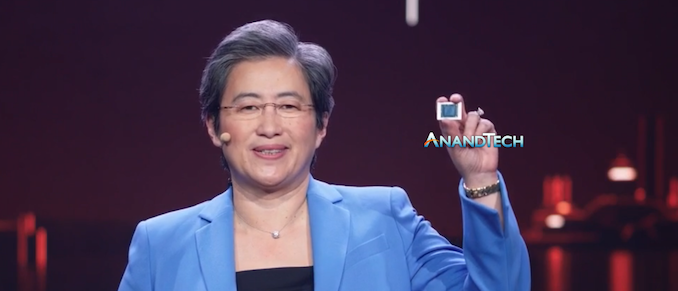
It has been a year since AMD launched its previous generation Ryzen Mobile processors. At the time, the update from Zen to Zen 2, as well as moving to TSMC’s 7nm manufacturing process, gave the company the biggest boost in its notebook performance and battery life in AMD’s history. It’s difficult to reinvent the wheel again, but AMD is hoping that its new Ryzen 5000 Mobile processors build on the momentum that started last year. The new processor line-up has 13 new models, targeting the traditional U series and H series markets, as well as a couple of new areas AMD is looking to expand into.
AMD Ryzen 5000 Mobile:
8 Cores of Zen 3
8 Compute Units of Vega
For those familiar with the previous generation of Ryzen 4000 Mobile, then the situation for these new processors is relatively simple: replace the Zen 2 cores with Zen 3 cores, combine the L3 cache, double the L3 cache, and that’s about it.
For everyone else, what we have here is a single piece of silicon that contains one group of eight Zen 3 cores that share a single 16 MB non-inclusive L3 cache. AMD’s big marketing tool for the other Zen 3 families on the desktop is that the size of the L3 cache effectively reduces main memory latency and helps gaming performance, and so with the new mobile processor they’ve combined the two four-core complexes into a single eight-core complex, then doubled the amount of cache, enabling each processor to have access to all the cache on the CPU at the same time.
These cache updates work in line with core updates that the Zen 3 core microarchitecture provides. We’ve covered the Zen 3 microarchitecture in our desktop processor review, which you can read here. Just replace the L3 cache numbers with 16 MB to get a sense of what the mobile processors will have.
For graphics, there are no updates moving from Ryzen 4000 to Ryzen 5000, and we still have eight compute units of Vega-era design. This will be a bit of a frustration for a few users that may have been hoping for some RDNA2 level updates to push performance along, especially with the added efficiency and performance gains that an RDNA2 design should have possibly brought to the table. The simple matter here is that when AMD put Vega on its Ryzen 4000 Mobile in 7nm, the efficiency was increased enough that enabled sustained development and kept AMD on cadence for its next generation. We’re at a stage now where AMD might consider updating the CPU/GPU on its APUs in alternate years, if that keeps the rate of product releases in line with its other designs.
For additional connectivity, we expect the Ryzen 5000 Mobile processors to also keep the same as the previous generation: eight lanes of PCIe 3.0, support for NVMe and SATA, and DDR4-3200 / LPDDR4X-4266. Again, leveraging the previous generation design helps AMD’s generational time-to-market (something that AMD has been saying it needs to keep track to), but we do perhaps expect updates next time around.
While we don’t have a Ryzen 5000 Mobile silicon die on hand (something we lose by not having a physical CES event this year, but totally understandable), because the Zen 3 cores are slightly larger than the Zen 2 cores, overall the die size of Ryzen 5000 Mobile should be slightly bigger. This should not have much of an effect on designs, depending on how the packages arrange their pin-out design. Given the similarities, it is possible for the pin-out to be identical to the previous generation.
All of AMD’s Ryzen 5000 Mobile processors (3 exceptions, listed below) are binned from this one silicon die design.
Ryzen 5000 Mobile, H-Series: H, HS, and new HX
AMD’s top tier mobile parts are all in the H-series. Traditionally these processors are listed with a TDP of 45 W, however last year we saw AMD experimenting with a newer 35 W category called ‘HS’. This year AMD is again introducing a new level called ‘HX’ for its overclocking models, going above the standard H-series TDP.
| AMD Ryzen 5000 Mobile: H-Series | |||||
| AnandTech | Cores Threads |
Base Freq |
Boost Freq |
TDP | Zen |
| Ryzen 9 5980HX | 8C / 16T | 3300 | 4800 | 45W+ | Zen3 |
| Ryzen 9 5980HS | 8C / 16T | 3000 | 4800 | 35W | Zen3 |
| Ryzen 9 5900HX | 8C / 16T | 3300 | 4600 | 45W+ | Zen3 |
| Ryzen 9 5900HS | 8C / 16T | 3000 | 4600 | 35W | Zen3 |
| Ryzen 7 5800H | 8C / 16T | 3200 | 4400 | 45W | Zen3 |
| Ryzen 7 5800HS | 8C / 16T | 2800 | 4400 | 35W | Zen3 |
| Ryzen 5 5600H | 6C / 12T | 3300 | 4200 | 45W | Zen3 |
| Ryzen 5 5600HS | 6C / 12T | 3000 | 4200 | 35W | Zen3 |
These two series, HS and HX, represent different strategies for AMD. Last year when HS was introduced, AMD stated that these 35 W models were special, requiring system design approval from AMD in order to have access to them, as they enabled the same base and turbo frequencies but at a much better efficiency point. This year that distinction seems to have dropped away a bit, with the HS models now simply giving the same turbo but lower base frequency than the standard H. Note that the change in TDP, from 45 W to 35 W, in the various TDP modes, typically relates to changes in base frequency, so in that instance AMD is more aligned with what the market is used to.
For HX, this changes AMD’s offering. Overclockable models in laptops isn’t necessarily new (Intel has done it for years), but AMD has taken the detail to explain that the TDP is raised to a ‘45W+’ design for these parts. This allows the OEM partners to ultimately define their TDP level, and have the sustained base frequency increased match expectations for the hardware it is built for. This means that desktop-replacement devices can fully turbo up to 65 W (or higher?) as needed, rather than those OEMs having to reply on building a socketed platform in a portable chassis.
Users might also note that the Ryzen 9 processors here do not have traditional H series parts. Because the mobile market is always a bit odd in its numbering scheme, the Ryzen 7 5800H takes that role, because it still has eight cores. If OEMs want the Ryzen 9 branding, they either have to build something sleeker for a 35W HS, or something beefier for the 45W+ HX.
AMD is advertising the Ryzen 9 5980HS as the best processor for portable gaming performance, whereas the Ryzen 9 5980HX as the best mobile processor for gaming. AMD showcases the 35 W model as scoring 600+ in Cinebench R20, in line with the desktop Zen 3 processors launched last year.
Ryzen 5000 Mobile: U Series (not all Zen 3)
The U-series portfolio is where AMD’s processor cycle updates cause a bit of bother. In a normal product cycle, we expect everything to be upgraded from the older to the newer, however this time around AMD is mixing and matching the U-series 15 W products between Zen 2 and Zen 3. So while there are new Zen 3 hardware options at 15 W, some of these processors are simply re-badges of Ryzen 4000 Mobile instead.
| AMD Ryzen 5000 Mobile: U-Series | |||||
| AnandTech | Cores Threads |
Base Freq |
Boost Freq |
TDP | Zen |
| Zen3 | |||||
| Ryzen 7 5800U | 8C / 16T | 1900 | 4400 | 15W | Zen3 |
| Ryzen 5 5600U | 6C / 12T | 2300 | 4200 | 15W | Zen3 |
| Zen2 | |||||
| Ryzen 7 5700U | 8C / 16T | 1800 | 4300 | 15W | Zen2 |
| Ryzen 5 5500U | 6C / 12T | 2100 | 4000 | 15W | Zen2 |
| Ryzen 3 5300U | 4C / 8T | 2600 | 3800 | 15W | Zen2 |
The top processor is the Ryzen 7 5800U, which is Zen 3, and there is also a Ryzen 5 5600U, which is also Zen 3. However, the others are Zen 2 based, using the same Renoir die as Ryzen 4000 Mobile.
Reasons for offering a re-badge can be confusing. Normally it is done to appease OEM partners that have a singular design and want to get the benefit of the latest generation nomenclature but not have the expense of developing a new unit. AMD’s public reasoning here has not been given, although in the past we’ve seen it beholden to its OEM partners (Carrizo and Carrizo-L) for this sort of co-design.
Despite this, AMD is promoting the Ryzen 7 5800U as its most efficient mobile processor to date, citing 21.4 hours battery life on a 53 Wh battery during 1080p video playback with Wi-Fi on, or 17.5 hours in MobileMark 2018’s battery life test. The footnotes state this was an AMD reference platform, though details on screen brightness were not given.
Overall, AMD is citing that they will have 150+ design wins this year for Ryzen 5000 Mobile, compared to 100+ for Ryzen 4000 Mobile. Availability for these systems, both the U-series and H-series, should start this February.


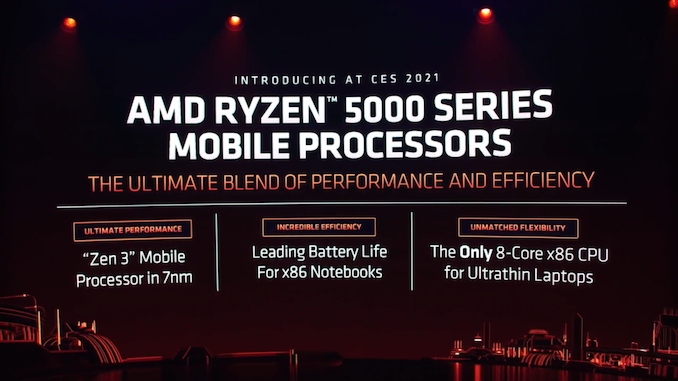
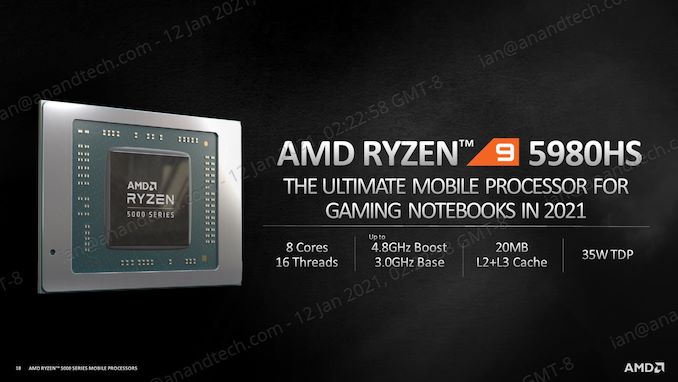
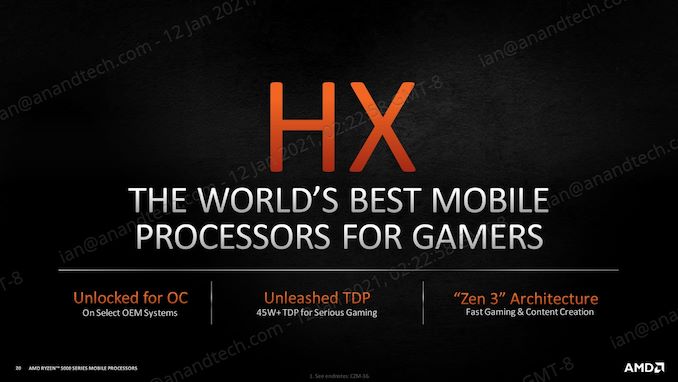
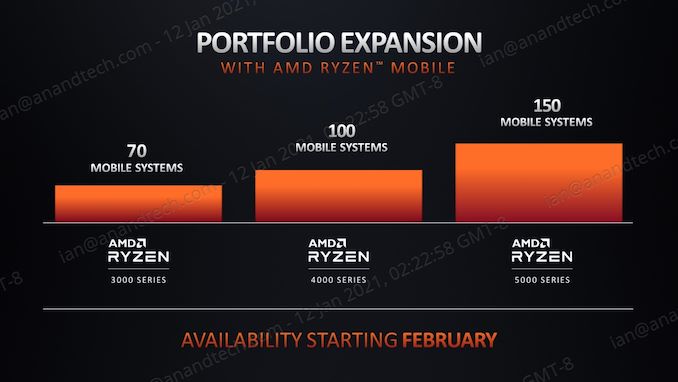








117 Comments
View All Comments
Spunjji - Friday, January 15, 2021 - link
Nice to see a balanced opinion! I suspect we'll see AMD retake the iGPU crown back when they can combine the area benefits of 5nm with DDR5 - they won't need to use the area for more CPU cores this time around, so they could squeeze in more RDNA2 ALUs and maybe even a nice big cache for it.marrakech - Thursday, January 14, 2021 - link
so geekbench is an good benchmark?Ryzen 9 5900HX that was seen on Geekbench 5.3 racing at 4.59 GHz and producing a mighty single-core result of 1,423 points but a muted multi-core result of 6,912 points. Well it seems things have been properly tweaked, as Tum Apisak has found an Asus ROG Zephyrus Duo 15 SE (GX551QS) machine soaring at 4.74 GHz and coughing up a still great single-core score of 1,547 points and a huge multi-core score of 9,069 points
6900 to 9000 is some tweaking , either one was run on eco mode or what is going on?
id say an benchmark that has 2000 points diffrence on same cpu is abit scewed
SolarBear28 - Thursday, January 14, 2021 - link
The TDP of the Ryzen 9 5900HX can be configured from 35-54 W. Plus all of the usual power mode, OEM firmware and thermal solution variables that could affect the results.Spunjji - Friday, January 15, 2021 - link
This - the dramatic difference between the two scores suggests the first device was hitting thermal limits will all 8 cores loaded. This is the problem with notebook SoC performance links - we have no idea about cooling!marrakech - Saturday, January 23, 2021 - link
https://browser.geekbench.com/v5/cpu/6041506 17 ROG Strixsame laptop is leader in passmark cpu test 25000 (this goes over 60000 for treadripper parts)
... https://i.postimg.cc/PxvrnVrL/Screenshot-576.png
on the left is the rog strix compared to an 1 year old 4800h part
so in one banch its on top in other its very low?
ECC_or_GTFO - Friday, January 15, 2021 - link
Can one of you with connections please contact the laptop makers and get them to support ECC on the motherboard? It doesn't have to come with it - but just support it; the CPU does! It would be cheap & huge with the enthusiast - preferably Thinkpad.Also get them to hire a guy like this for a friggin month to tune it so we can have low power like Apple's M1: https://www.reddit.com/r/hardware/comments/k3iobs/...
Thanks! Such a paint to get someone's ear at these hardware companies these days... Despite working in "silicon valley" for a decade...
Meteor2 - Saturday, January 16, 2021 - link
Cannot believe they're doing an Intel on the U-series. Absolute stupidity.Gondalf - Saturday, January 16, 2021 - link
No, unfortunately in U serie they are in a bad situation. 8 cores do not fit in 15W and Zen 3 is notoriously a lil power hungry for 7nm. So they have few low power good dies with Zen 3 and many low power good dies on Zen 2. It is a matter of binning. They are constrained to stay on Zen 2 for power consumption reasons, funny enough in the cpus that will sell more, aka 5700 U, 5500U, 5300 UOne this is certain with the arrive of Tiger Lake 8 cores, the landscape will change radically.
Anyway, Amd have not enough silicon, so to Intel care nothing of Amd claims.
There is another issue, the battery life, Amd laptops are a delusion in this champ, the reason is AMD U APUs are 25W and definitively not 15 W. Amd is not fair here.
Actual real TDP of Amd APUs are 25W, 35W,45W, 45W+++.
SolarBear28 - Sunday, January 17, 2021 - link
That is a giant load of imaginary crap. Zen 3 power consumption is almost identical to Zen 2 at the same frequency. With the 19% IPC increase Zen 3 will be even more efficient than Zen 2 in real world usage in laptops. You say 8 cores do not fit in 15W? AMD has already done it. I'm typing on a T14s with Ryzen 7 Pro 4750U. Great battery life. Better sustained performance and efficiency under load than any product Intel has ever made for thin laptops. 25W PL2, 18W PL1 yet destroys the Intel i5-10210u (in the same laptop with the same power limits) and keeps up with a 45W i7-10875H. The only truth in your comment is that AMD does not yet have the production capacity to realize the market share their CPU's would otherwise have.https://www.notebookcheck.net/Lenovo-ThinkPad-T14s...
Smell This - Sunday, January 17, 2021 - link
No worries ___ Gondaft is all about the propaganda.
Ian is busy enough, but a blow-by-blow deep dive (complete with die shots!) would answer multiple questions between AMD and Chipzillah, including actual power consumption and "core" (both CPU and graphic engine) efficiencies.
I'm thinking 'Daftie would likely not enjoy Vega 8 CUs versus Xe 96 EUs in any metric, much less with an incoming Little Navi iGPU.